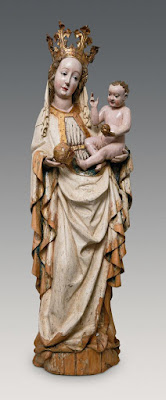Johannes Aquila is most famous for not only signing his work, but also for painting his self-portrait. The self-portrait can be seen next to his signature, in a praying position (similarly to depictions of patrons) both at Velemér (1378) and at Mártonhely (1392). These are regarded as the oldest European self-portraits by a painter, and you can read more about in an article by Daniel Spanke (Spanke, Daniel, "Die ältesten Selbstbildnisse Europas? Zur Bedeutung der Malerdarstellungen Johannes Aquilas von Radkersburg in Velemér (1378) und Martjanci (1392) für eine Frühgeschichte des Porträts," Zbornik za umetnostno zgodonivo 34 (1998), 141-159, available in a pdf format).
A new book has just been published on this highly important painter, written by Terézia Kerny with photographs by Zoltán Móser (Kerny, Terézia - Móser, Zoltán: Képet öltött az Ige - Johannes Aquila freskói. Budapest, Kairosz, 2010). The book will be presented by Mária Prokopp on Tuesday, January 25 at Litea Literature & Tea Bookshop. The book is in Hungarian, but hopefully will be published in other languages as well.
I cannot post my own photos of the frescoes here, because the last time I visited these churches I still used slides - and those have not been scanned yet. To the left, you can see the self-portait of Johannes Aquila from Mártonhely (Martjanci), and you can find several other photos online, especially of Velemér:
Photos of the church, with Quicktime virtual reality views of the interior; more photos at the Fine Arts in Hungary website.
For more photos, visit the IMAREAL database of the Institut für Realienkunde des Mittelalters at Krems (search for Künstler: Johannes von Aquila [um 1400 tätig], or for Standorte: Turnisce and Martjanci. Does not seem to work in Chrome).


















